MIL-HDBK-61A: Configuration Control
< Previous | Contents | Next >
6.2 Engineering Change Proposal
An Engineering Change Proposal (ECP) is the management tool used to propose a configuration change to a CI and its Government-baselined performance requirements and configuration documentation during acquisition (and during post-acquisition if the Government is the CDCA for the configuration documentation).
The following paragraphs define uniform concepts and principles by which the processing of ECPs is conducted. These standard ground rules are necessary to assure that there is a consistency and orderly process that can be expeditiously accomplished by all parties.
The concepts in this section apply to class I ECPs, except where specifically identified as applicable to class II ECPs.
6.2.1.1 ECP Initiation.
The initiation of an ECP begins at the government's request unless for one or more of the reasons cited in paragraph b. below. Since most ECPs occur in a sole source environment, the initiation of an ECP should be a well-planned and coordinated effort between the government and contractor. A clear mutual understanding of the ECP objective, technical scope and the Government's performance, cost and schedule constraints shortens the lead-time for ECP preparation. It also results in a complete and comprehensive proposal to facilitate timely and effective implementation. As with most processes, the three C's: Communication, Cooperation and Coordination are the keys to assuring successful change processing.
The "ECP Management Guide," [Detail: Appendix D] has been developed to assist both the Government and contractor during the request, preparation, approval and implementing phases of an ECP. It provides checklists to aid in the timely identification and coordination of essential technical information required for decision making in all three stages of the ECP process. It also fosters the integrated product and process team concept.
a. Solicited ECPs.
Whenever the government identifies a need or requirement to change a CI and its configuration documentation a Class I ECP is formally requested from the contractor. A request for an ECP is coordinated with the applicable government Contracting Officer prior to being released to the contractor. [Refer to: Check List (A) of Appendix D]
b. Unsolicited ECPs.
As a general rule, unsolicited Class I ECPs are discouraged. However, at the discretion of the procuring activity, a preliminary ECP may be submitted to allow evaluation of the desirability of expending resources to fully document a proposed change. Changes that impact the following areas are instances where unsolicited ECPs may be justified:
-
Safety
-
Compatibility.
-
Correction of Defects.
-
Survivability.
-
Security.
-
Product improvement(s) that may significantly reduce life cycle costs, including Value Engineering Change Proposals (VECP) consistent with the DFAR Value Engineering clause of the applicable contract
-
Technology improvements
6.2.1.2 ECP Preparation and Submittal.
Formal and preliminary ECPs are prepared and submitted to the Government in accordance with the configuration management requirements of the applicable contract SOW and associated Contract Data Requirements List (CDRL), DD Form 1423 citing the latest approved Data Item Description (DID) for submittal of ECP data. The contract CDRL should provide information on submittal and distribution of ECPs for Government review and processing.
The contractor (ECP Originator) should notify the Government immediately by electronic message (e.g. E-mail, Fax) when the need for an emergency or urgent priority ECP is determined. Follow-up to a message ECP should be in the form of a formal ECP submittal, within 30 days. However when this is impracticable, a preliminary ECP may be used as an interim measure. Both the preliminary ECP (if used) and the final ECP resulting from a message ECP would be identified as revisions of the initial message ECP. [Detail: Activity Guide: Tables 6-3 and 6-4]
a. Automated Processing of ECPs.
If the Government has established a Government Configuration Management Automated Information System (CM AIS) the contract data requirement for ECPs should request either the digital submittal of ECP data, population of the DoD data base directly by the contractor, or access to the ECP via the world wide web. All ECP fields of information will be defined in the EIA Standard 836 data dictionary and its related XML ECP Business Object. To use MEARS as a standalone system, software must be provided to the contractor.
b. ECP Content by Program Life Cycle Phase.
Pertinent data fields of information (ECP data elements) that are to be provided by an ECP should be identified as described in the data item description and EIA-836. Only data fields that are populated need be provided with the ECP. Using the XML data field tags will enable Government and the various commercial configuration management information systems to store and coherently display the ECP data. A significant advantage of using electronic commerce over paper forms is that each topic may be addressed in its entirety without having to meet paper form block limitations. Obviously those key data fields that identify and describe the change are mandatory in any ECP. Common sense and the current context and environment of the program for which the ECP is being submitted dictate the fields to be populated. The typical content of an ECP may vary considerably during the CI's life cycle, and because DoD Directive 5000.1 gives Government Program Managers latitude in identifying the phases that they will employ, no two programs will necessarily be the same. The content guidance provided herein [Detail: Activity Guide: Table 6-6] reflects the general variability of ECP content that can be expected.
6.2.1.3 ECP Supporting Data.
Supporting data should include, where necessary, supplementary information to support the change description and justify the need for change. Test data, analyses and other technical documentation providing supporting rationale for assertions made in the ECP, and upon which the configuration control authority can base its acceptance of the proposed change, can be included to the extent that the originator feels is necessary. In many cases, the proposed change or its justification will be easier to understand if "marked-up" copies or draft revisions of the TDP element (such as a "redlined" copy of a portion of a specification or an interface drawing, or a draft table providing new values to be included in a data base) are also provided as a part of the ECP package.
6.2.1.4 Review and Dispositioning ECPs.
In order to facilitate dispositioning ECPs affecting documents for which the Government is CDCA, contracts should identify the government representative(s) responsible for dispositioning both Class I and Class II ECPs. Where the Government is an Application Activity (AA), or in a performance based acquisition, where the Government is not CDCA for the design documentation, contracts should clearly specify Government and contractor responsibilities for Class I ECPs and RFDs affecting Government baselined performance specifications. This can be accomplished by incorporating a special configuration control clause in the contract similar to the example in the box below. Guides for the dispositioning of Class I and Class II changes are provided in 6.2.2. [Detail: Activity Guide: Table 6-7] Key aspects of this process are highlighted, as follows:
Example:
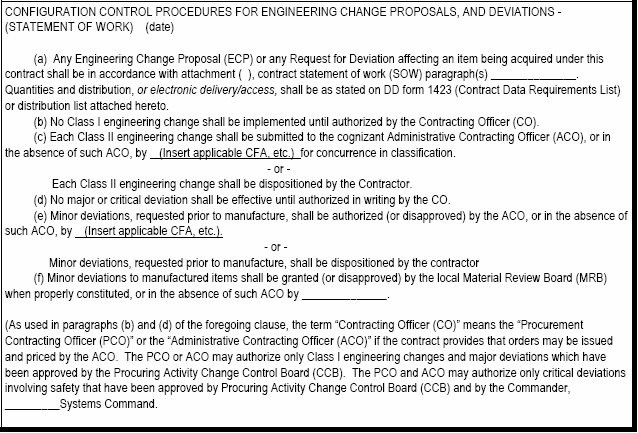
a. Dispositioning Class I ECPs.
Class I ECPs must be dispositioned (approved or disapproved) for implementation by a properly constituted Government Configuration Control Board (CCB).[See 6.1.1.3.a.] After the CCB direction is issued, it is important to proceed expeditiously with the "definitization" process (obtaining a pricing proposal, auditing, fact finding, and negotiating the final price) for this change and issuing a supplemental agreement. Until the contract modification is received and bi-laterally agreed to by the Government and the contractor, the contractor is not authorized to proceed with the implementation of the proposed change.
The contractual approval or disapproval of an ECP should not be confused with the acceptance and approval of the ECP as a data deliverable. Approval of the ECP data delivery required by CDRL/DD Form 1423 signifies only that the ECP satisfies the requirements of the ECP DID and is considered acceptable for government processing. Acceptance of the data deliverable does not signify "technical approval" of the change proposed by the ECP and should not be interpreted as authorizing the performing activity(s) to proceed with the work proposed by the ECP.
All ECPs should be dispositioned by the Government as expeditiously as possible. The ECP indicates a date by which contractual authorization is required. This date should normally be proposed by the contractor to allow sufficient processing time by the Government. In some cases, expedited processing may be necessary in order to minimize the cost of the change or to enable it to be incorporated in time to satisfy an operational need. Since certain critical factors (such as safety or national defense preparedness) may be involved, it is important that the Government proceed with all due speed, but it is also important to ensure that proper priorities and need dates are being specified.
Because there is considerable urgency involved in effecting the changes proposed in urgent and emergency ECPs, the contractor normally specifies an authorization suspense date that is very close to the submittal date (e.g. 48 hours to make the technical decision on an emergency ECP and 30 calendar days to make the decision on an urgent ECP). [Detail: Activity Guide: Table 6-5.]
When the urgent or emergency priority is properly used, the contractor must be authorized to proceed with implementing the change as quickly as possible. Under these circumstances, it is often necessary to utilize a unilateral change order to the contract (or contracting officer letter) to provide official authorization to proceed. If the change order is to be used, a "not-to-exceed" price quotation (a "not-less-than" price for cost reduction ECPs) would be required to set a limitation on the price impact of the change activities to be accomplished. After the change order is issued, it is important to proceed as expeditiously as possible with the normal "definitization" process to minimize the risk of related price increase (or to maximize the related savings) resulting from the change.
VECPs are subject to essentially the same CCB process as other ECPs. Under the FAR clause, the Government is entitled to reimbursement of expenses incurred in processing an approved VECP before any cost savings are shared out to the contractor. Therefore, the tasking activity must develop auditable government cost information so that the complete monetary impact of the VECP can be evaluated. Any delays in VECP processing will typically reduce the savings benefit.
b. Dispositioning Class II ECPs.
Unless otherwise specified by contract (e.g., as part of the Single Process Initiative), the government administrative contracting officer or plant representative serves as the dispositioning authority for Class II ECPs.. The default action required on Class II changes is concurrence/nonconcurrence in classification only, unless the contract requires approval/disapproval. Government concurrence in Class II ECP classification normally allows the contractor to incorporate the change in the applicable CI and update its configuration documentation without any further government action or authorization being required. A nonconcurrence in classification will normally result in the Class II ECP being canceled or reclassified to a Class I ECP.
The government should require approval/disapproval of class II ECPS only when the Government is the CDCA for the original drawings, or data files, and compliance with the specific detailed design is a requirement of the contract. If there is a government ACO or plant representative available, the Government tasking activity may elect to have the ACO or representative review the proposed class II changes for concurrence in classification before they are submitted to the government tasking/procuring activity (that is the CDCA) for approval [Details: Activity Guide: Table 6-7]
6.2.1.5 Implementing Class I ECPs.
When ECPs are approved, change implementation to a CI being produced under contract is usually a straightforward contractual incorporation of the ECP as approved by the government CCB. CCB approval action is not to be considered authority for the contractor or tasking activity to proceed with the change.
-
A CCB directive must be prepared, published and distributed. The CCB directive is identified by the CCB identifier and the change identifier. The date of the CCB directive and disposition are recorded. Distribution should be limited to those parties required to take action to implement the change
-
If implementation of the approved change is the responsibility of the contractor under the terms of a contract, the CCB approval action directs the procurement contracting officer to initiate instructions to the contractor
-
If Contractor-initiated change proposals are involved, the receipt of a formal contract change for example, Standard Form 30, "Amendment of Solicitation/Modification of contract" or PCO letter (pending receipt of an amendment) shall constitute sole authority for the contractor to proceed.
-
If the initiator is government activity acting in the capacity of a contractor, the receipt of the directive/order (including funding authorizations) shall constitute sole authority to proceed with the change.
Change implementation to a CI in the inventory or operational forces will normally require the coordination of additional requirements of an implementing CCB directive (or tasking order).
-
Necessary instructions and funding authorizations must be issued for the scheduled implementation of the changee
-
Change accomplishment reporting is directed. [Details: Activity Guide: Table 6-8]
The incorporation of approved changes should be planned so that optimum acquisition, production, tests, evaluation and operational advantages can be derived from the modified configuration. The change is effectively coordinated to ensure that the earliest possible availability and support of the CI is provided with minimum disruptive effect on planned operating cycles.
Changes shall be incorporated only after the Contract modification/PCO letter or implementing directive/order is published and logistic support is available, unless safety or critical mission requirements dictate otherwise. Unofficial or preliminary technical documents shall not be used as authority to incorporate changes.
The implementation of approved changes to a CI must always include the proposed incorporation of new and revised technical documentation. Provisions for change documentation should always be addressed by the change proposal, contract modification and/or CCB implementing directive/order. Change documentation may include such types of data as specifications, drawings, provisioning documentation, technical manuals, diagrams, sketches, parts lists, master configuration lists, computer program documentation, and test and evaluation procedures. Requirements for such change documentation may vary depending on the life-cycle phase, type and complexity of each CI and the change/modification. However, the documentation prepared for any change will normally include the following three categories:
-
The documentation package (including the CCB implementing directive/order) forwarded to the change installing activities to install the change.
-
The documentation required by the technical, training, maintenance, and supply management organizations to properly control and support the change.
-
The documentation (e.g., technical manuals) required by the user activities to properly operate and maintain the CI after the change is installed.
The following ECP Activity Guides provide information concerning change classification, the justification for Class I ECPs, the types of ECPs, ECP priorities, ECP content, and the ECP dispositioning actions that may apply. ECPs are prepared and submitted to the government in accordance with the configuration requirements of the applicable contract SOW and CDRL/DD Form 1423. If the Government has established a CM AIS, the data requirement for ECPs should request digital submittal of ECP data, population of the DoD database directly by the contractor.
Table 6-2. Activity Guide: Change Classification
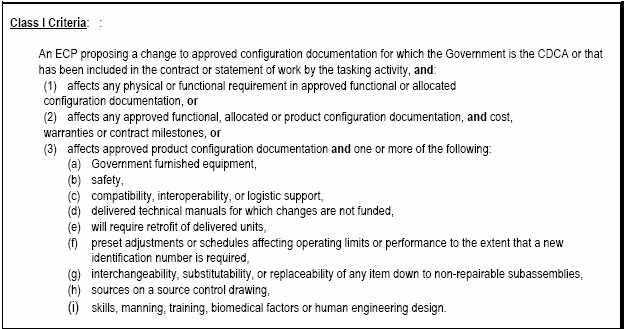
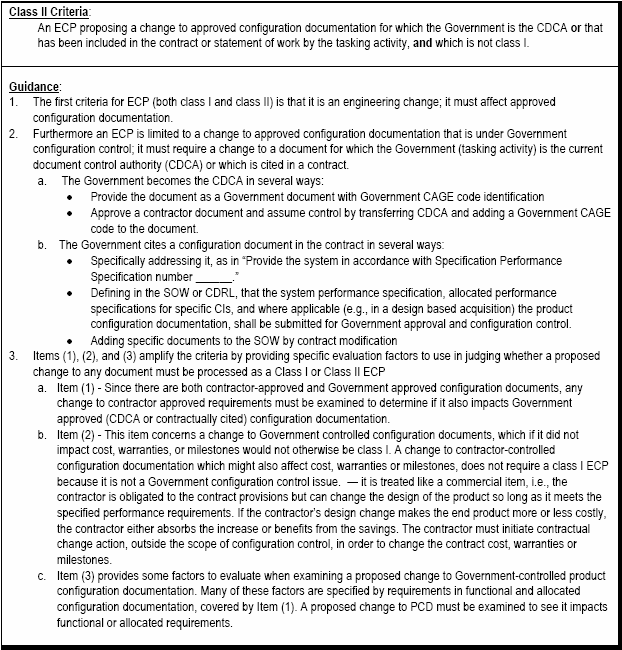
Table 6-3. Activity Guide: ECP Justification Codes
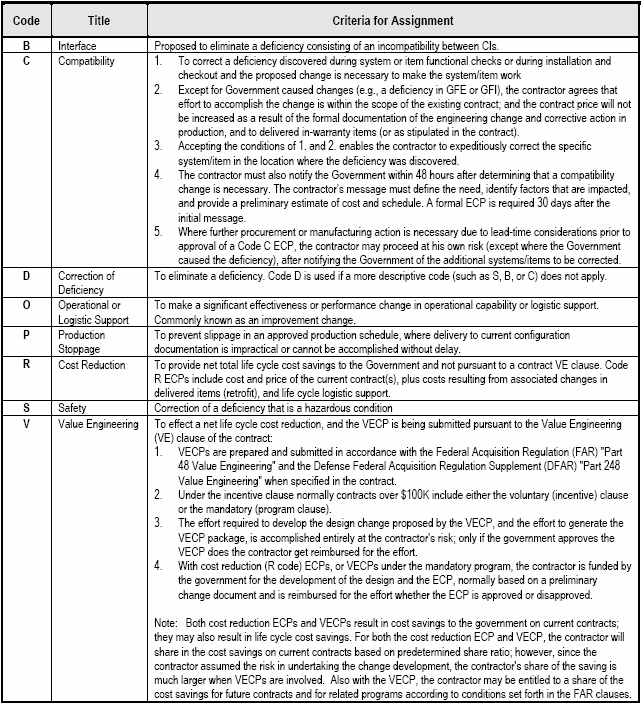
Table 6-4. Activity Guide: Class I ECP Types and Their Function
All types of Class I ECPS may be submitted to the Government electronically, the type categorization relates not to format but to give a quick indication of the intent of the ECP
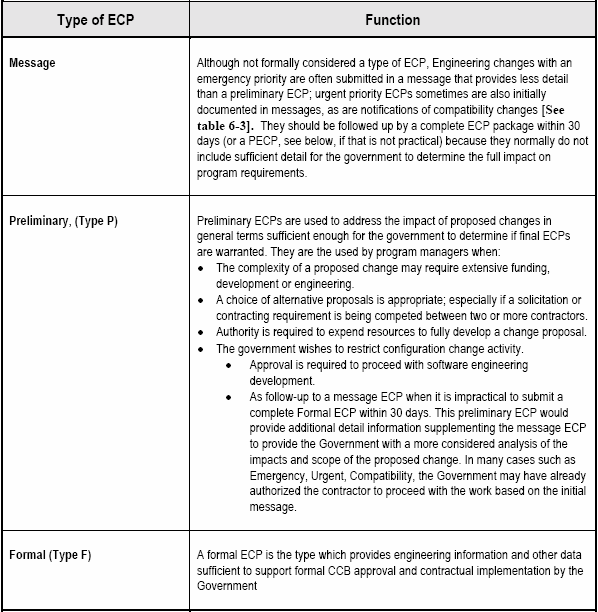
Table 6-5. Activity Guide: ECP Priorities
One of the following priorities shall be assigned to each Class I ECP by the originator to indicate the urgency with which the ECP is to be reviewed, evaluated, ordered, and implemented. (The proposed priority as assigned and will stand unless the tasking activity has a valid reason for changing the priority.)
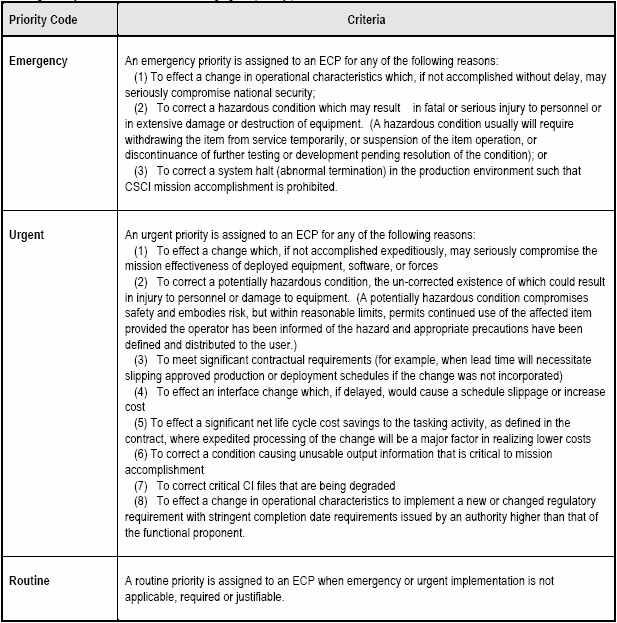
Table 6-6. Activity Guide: ECP Content
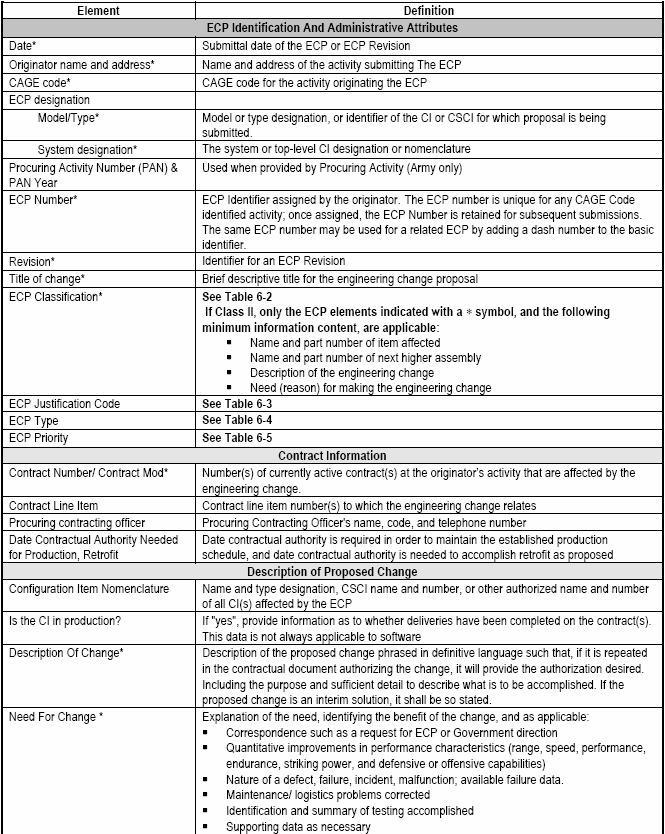
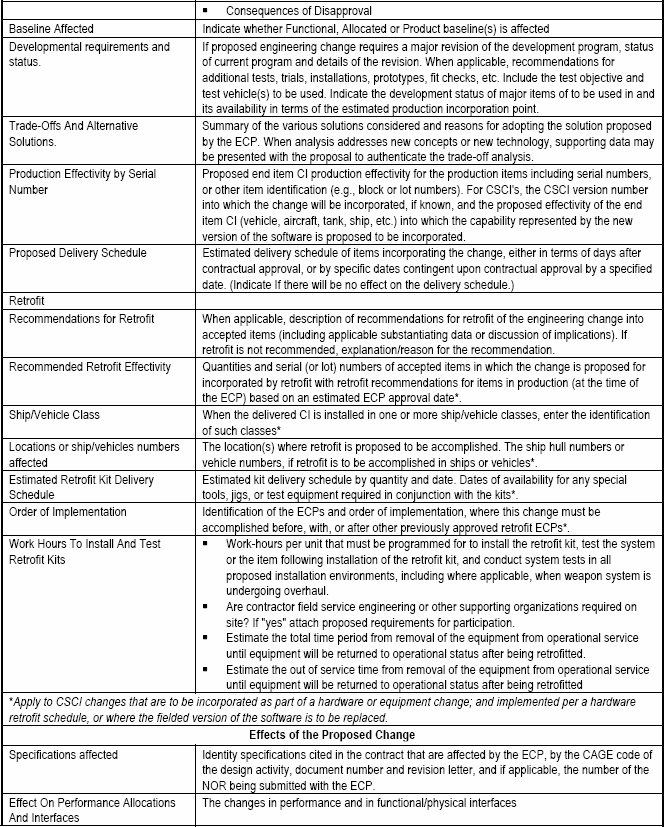
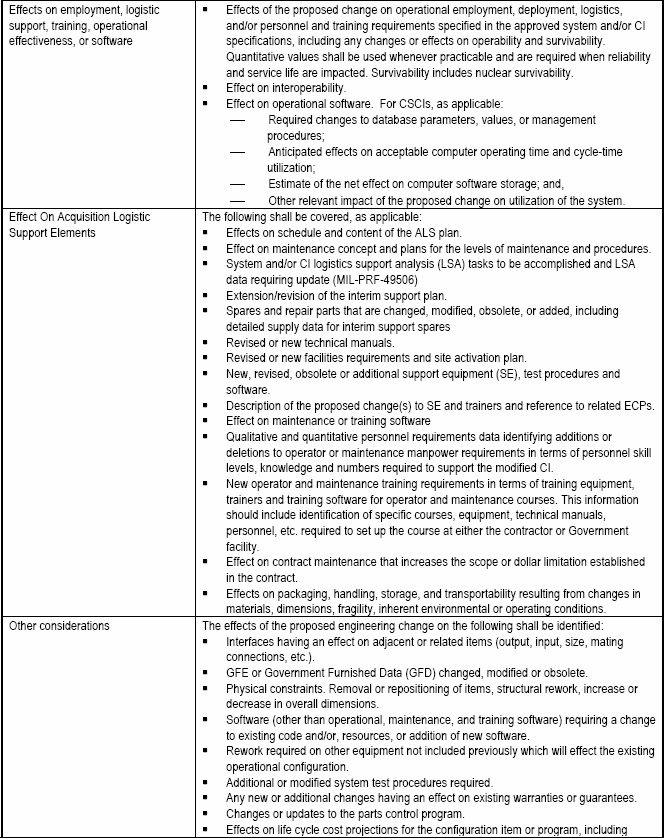
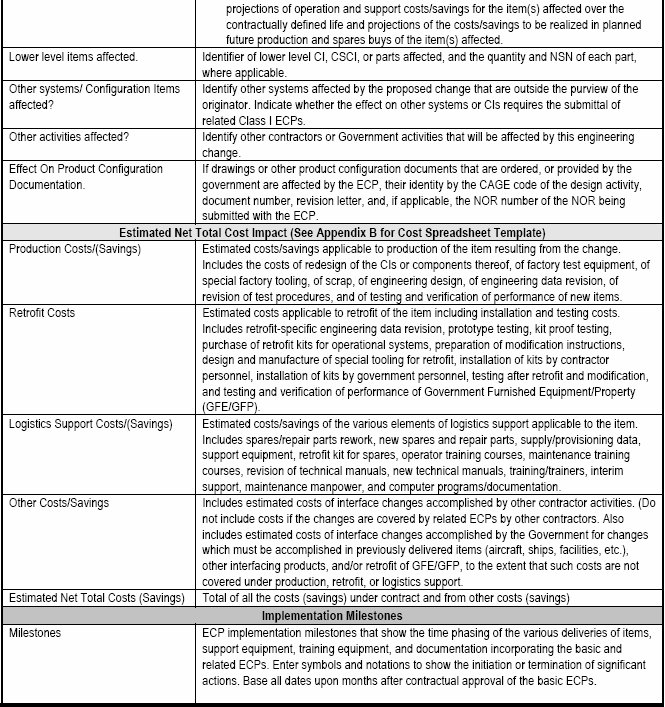
Table 6-7. Activity Guide: ECP Review and Disposition Actions
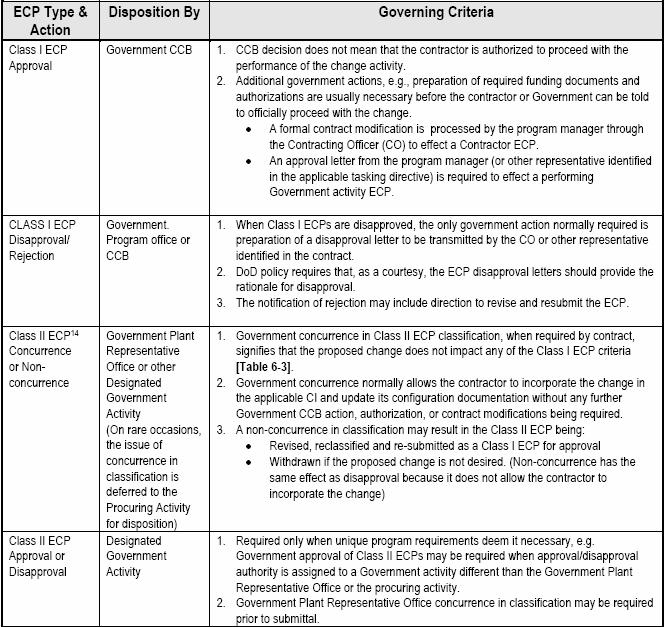
Table 6-8. Activity Guide: ECP Implementation Actions
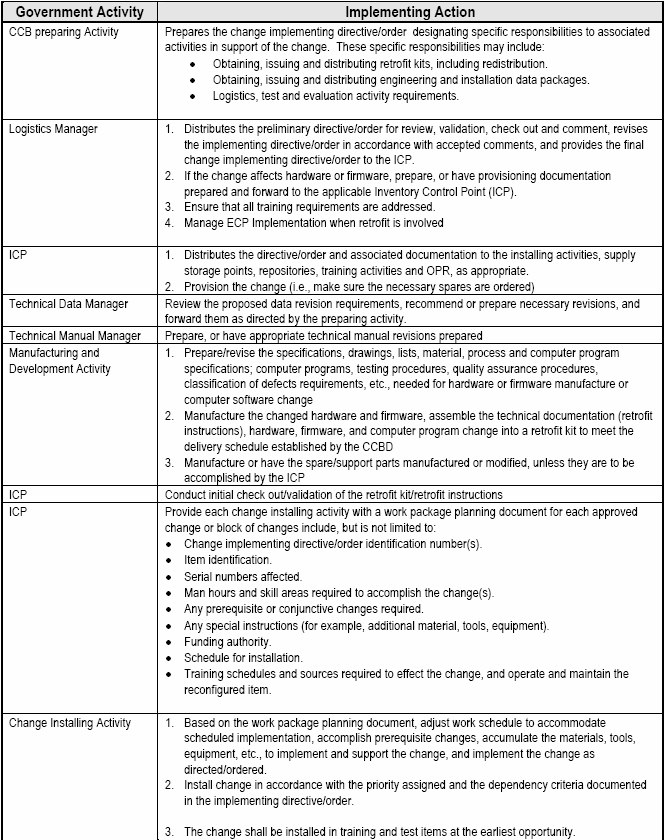
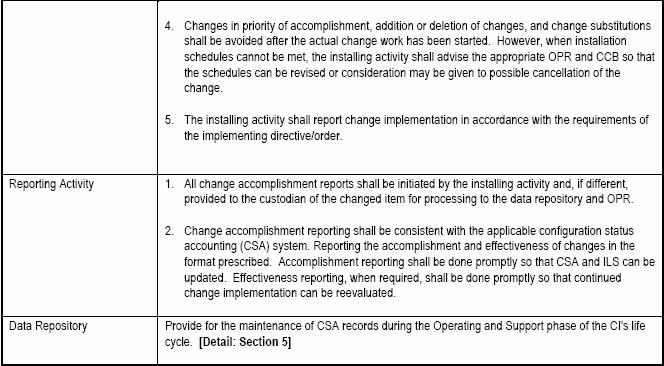
The OPR for MEARS is Commander, US Army MICOM, Attention: AMSMI-MMC-LS-SA (Mr. Mark Moe) Redstone Arsenal, Alabama, 35898-5238, DSN 746-9513
For correct application of this information, see NOTE on Contents page